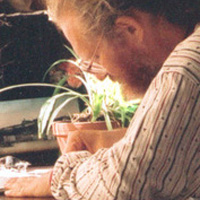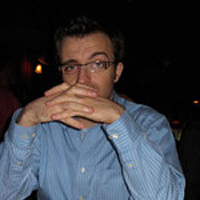
This year I attended the full programme at ATypI 2013 Amsterdam "Point Counter Point". The main part of the conference is always preceded by two days devoted to two tracks of programming, with close focus on specific techniques and ideas, plus workshops (which I didn't attend). Even though I have no academic background in typography nor type design nor am I involved in any aspect of type production I found this more "technical part" incredibly interesting. On day one I often switched between the Non-Latin track and the Technology track to see as many presentations as possible. The twenty-minute format did not always work for me because often the engrossing content left me wanting for more.

The Mergenthaler Linotype 22-pt Arabic likely was the first Arabic Linotype fount ever made. From Specimen Book of Type Styles, 1915 (detail), p.483.
The conference got off a great start on the Non-Latin track with Titus Nemeth's Complexities and Simplifications: Counterpoints in Arabic typography. I loved his presentation with Kutlu Çanlıoğlu at TYPO London 2011 "Places" on BBC's global experience language in 27 languages and 9 scripts, where Titus focused on his Arabic/Latin family Nassim – see also his lovely Aisha, both available from Rosetta – which he originally designed as a partial requirement for the fulfillment of his MA in Typeface Design. Titus subsequently did his PhD research on Arabic type making, and this formed the foundation for his presentation exploring two, seemingly contradictory, notions of Arabic type design: complexity and simplification. Again he didn't disappoint: Titus took the audience on a journey of discovery, researching how the Arabic script was reproduced in type throughout the 20th century. Given the complexity of the Arabic scripts with their multitude of shapes and connections, the challenges to be overcome and the solutions were fascinating. Along the way Titus pieced together a partial history of Arabic metal types through select historical case studies. His twenty minutes were over way too soon.

Twenty minutes was however the perfect length for From historical revival to multilingual font family, Viktor Kharyk's account of his reconstruction of Ladoga (Anatoliy Shchukin, 1960s; Viktor Kharyk, 2005–2006), one of the most beautiful serif typefaces from the Soviet era typeface. The presentation gave an overview of its initial conversion into a digital type family, of the differing approaches for the text and the display cuts, and of the research that went its expansion into a multilingual family that already has won two competitions. Particularly interesting was how Viktor solved the problem of harmonious coexistence of different writing systems in one typeface using the universal capabilities of the broad pen, adapting its stroke direction and rotation according to the specific character of each script. With so many scripts already supported, the work ahead to include Ethiopian, Devanagari, Kanji, Katakana, Hangul and so on still looked daunting. Although I usually dislike slides spelling out the text of the presentation, this time it helped cross the language barrier.
This is where I switched to the Technology track, as the title for Cesar Puertas's presentation had me intrigued. Because I always have been very interested in science and mathematics Algorithm for the assessment of text typefaces using design parameters looked promising. Selecting type can be such a complex topic that adding an objective, rational factor into the mix could substantially simplify things. The mention of Gerrit Noordzij's theories and Erik van Blokland's Typecooker methodology gave me hope, but ultimately Cesar's system of using metrics data failed to convince me. His solution could for example single out ITC Avant Garde Gothic as a very legible text face, just like Monotype erroneously did on their blog, which of course it is absolutely not. Case in point – I once tried to read an article of mine printed in Grafik magazine back when the body copy was set in ITC Avant Garde Gothic, and I barely managed to get halfway through my own friggin' article before giving up. I am afraid we still have a long way to go before a trustworthy algorithmic approach can be developed (if it even is possible at all). Type is much more than just math and contours.
More data driven research was to be found in Erik van Blokland's experiment on digitisation of letter forms. It echoes my own research for my early conference presentations about plagiarism and sampling in type design at TypeCon, ATypI Helsinki and Brighton, and TYPO Berlin from 2005 to 2007. Whereas I opted for a purely mathematical method to prove that it is impossible to have node points matching up in two "different" type designs, Erik used his position as teacher and type designer to take an empirical (and in my opinion far more exciting) approach. On Digitization Erik explained how a single scanned image of a lowercase 'n' was shared with type students, colleagues, professionals and interested designers who were then asked to digitise it as faithfully as possible (he is still looking for type designers to help him with this project). The raw data of the contributed digitisations were interpolated with their normalised versions. Normalisation removes scale and offset from the group which makes it possible to compare the shapes. Erik's very thorough analysis of the data, taking into account every possible variable, made him come to the same conclusion as my theoretical approach did. As soon as more than two node points match up – and we're not even talking about the Bézier handles – it is not an original typeface, but outlines from another typeface were reused. As in: stolen, plagiarised, ripped off. Just so you know.

After the coffee break it was back to the Non-Latin track to see Mission impossible: Making Mongolian & Balinese Work in Digital Type. The duo presentation turned out to be a solo one – my compatriot Jo De Baerdemaeker had come down with the flu, so it was up to Rainer Erich Scheichelbauer who had been briefed by Jo about his parts of the presentation. Fortunately Erich is a terrific public speaker and had no problems compensating for Jo's absence. Due to their unique rules and morphology traditional Mongolian and Balinese scripts pose serious technical challenges. Again it was interesting to see how these were solved in the era of metal type, and how current type design software and technology can finally provide adequate solutions. It never fails to amaze me when I see with which (deceptive?) ease OpenType technology manages to tackle complex scripts with mind-boggling positioning and connections.
Even though it could have been just as well on the Non-Latin track, Mirjam Somers' Technology designed for Arabic had been assigned to the Technology track. DecoType are the masters of digital composition of Arabic, so I was keen to find out more about this. However, after her allotted time slot Mirjam switched to a portfolio presentation that quickly devolved in embarrassing self-praise, and by doing so went way overtime. I found this quite disrespectful towards the audience and the next speakers (this also happened at ISType where we both presented last June). Please, stick to the programme and let other people praise your work. Don't do it yourself, it is very unbecoming. I am fairly confident everyone in the room was aware of DecoType's mastery in Arabic typesetting tools, and if they initially weren't they sure were after seeing the impressive technical part of the presentation.
In their presentation Reinventing digital type design Yuri Yarmola and Adam Twardoch showcased Victoria, a new tool for digital type design they started building from scratch in 2011. It seemed like a radical new way of approaching type design with some very surprising and awe-inspiring features. However, as I am not a type designer myself I had no way of assessing how much of it was flash and how much truly useful. Still, there were some really novel ideas and fun capabilities on display. I am curious if this new direction will help FontLab regain some foothold now that they have such stiff competition from RoboFont and Glyphs.app.
Speed Punk Trailer from Yanone on Vimeo.
I have to confess I slipped out of Speed Punk: Understand Bézier curvature, simply because I already had seen it before. Yanone is one of these exciting ambivalent thinkers in the type world, designing type and developing tools to improve his own (and others' workflow). Speed Punk is one of these tools, teaching to better understand the nature of Bézier curves and their curvature, the technical basis of digital type design. This add-on for type design applications such Glyphs.app and RoboFont illustrates the curvature on top of the Bézier outlines — while designing.
After the information-packed morning it was time to have lunch and catch my breath. The lunch buffet by the way was excellent, as was the location in the wonderful Winter Garden at the Grand Krasnapolsky. Then it was time for the afternoon sessions, and the first one – the Free Fonts: Threat, or Menace? panel – warrants its own opinion piece.










